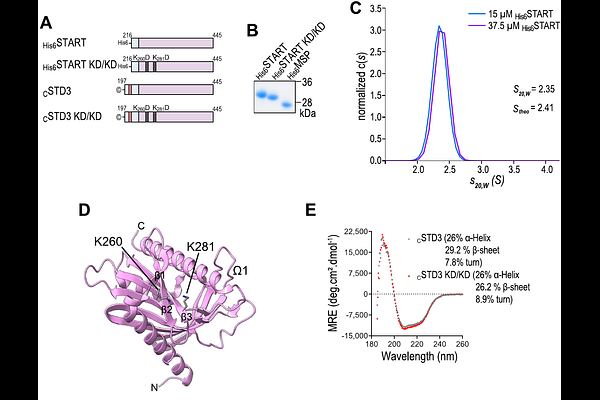STARD3 coordinates Endoplasmic Reticulum-late endosome/lysosome contacts and organelle positioning through a GSK3-regulated phosphorylation switch

STARD3 coordinates Endoplasmic Reticulum-late endosome/lysosome contacts and organelle positioning through a GSK3-regulated phosphorylation switch
Eichler, J.; Wendling, C.; Huver, S.; Zouiouich, M.; Hanss, V.; Cardinal, A.; Fimbel, V.; Birck, C.; McEwen, A. G.; Knorr, C.; Fromental-Ramain, C.; Boutry, M.; Chenard, M.-P.; DRIN, G.; Tomasetto, C.; ALPY, F.
AbstractMembrane contact sites (MCS) are dynamic regions where the membranes of two organelles come into close apposition. MCSs play many roles in cellular homeostasis by facilitating inter-organelle lipid and ion exchange as well as organelle positioning. The late endosome/lysosome (LE/Lys) cholesterol transfer protein STARD3 (StAR-related lipid transfer (START) domain containing protein 3) forms reversible contacts between the LE/Lys and the endoplasmic reticulum (ER). This tether protein contains a Phospho-FFAT motif (two phenylalanines (FF) in an acidic tract (AT)) whose interaction with ER-resident VAP proteins is phosphorylation-dependent. In this study, we identify Glycogen Synthase Kinase 3 (GSK3 and GSK3{beta}) as the kinases responsible for phosphorylating serine 209 within the Phospho-FFAT motif of STARD3. This phosphorylation event is both necessary and sufficient to activate STARD3\'s tethering activity, thereby promoting ER-LE/Lys contacts. Furthermore, we show that the ER-LE/Lys tethering activity made by STARD3 regulates endosome positioning, revealing an additional function for STARD3 on endosome biology. Our findings establish a direct and critical role for GSK3 in regulating MCS dynamics via STARD3 phosphorylation. This novel insight into GSK3-mediated phosphorylation expands our understanding of the molecular mechanisms governing inter-organelle communication.